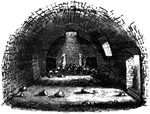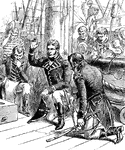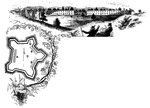1763-1788 American Revolution Camp Life
The 1763-1788 American Revolution Camp Life ClipArt gallery offers 6 illustrations of life in the military during the American War of Independence.

Bakery
The bakery. Near the southeastern angle of the range of barracks is the bakery; it is an under-ground…

Before Battle Prayer
The crew of a naval ship in the Revolutionary War praying before they head in to battle.

British Troops on Concord Common
"1. Companies of the Regulars marching into Concord. 2. Companies of the Regulars drawn up in order.…

Camp Ground
"View of the Camp Ground. This is from a painting by Tice, in my possession. The land on which the encampment…

Western Line of Barracks
Western line of barracks. There were four large buildings used for barracks within the fort, the walls…
